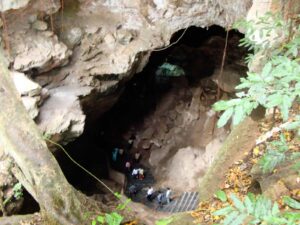
The Borra Caves are located on the East Coast of India, in the Ananthagiri hills of the Araku valley of the Visakhapatnam district in Seemandhra. Borra caves get their name from a formation inside the caves that looks like the human brain, which in the local language, Telugu, is known as borra. Borra caves are highly renowned for their attractive stalactite and stalagmite formations.
The caves discovered by William King George in 1807 are said to have originated from the river Gosthani due to its continuous flow of action over the limestone terrain. Legend has it that the Borra caves were discovered by native tribals when a cow grazing atop the caves fell through a hole in the roof.
A stone resembling a Lingam was found inside the cave which was believed to be an interpretation of Lord Shiva who protected the cow. In honour of this belief a small temple for Lord Shiva has been built outside the cave that draws a lot of devotees. Local people flock to the caves daily to worship the Shivalinga and the stone idol of the holy cow or Kamadhenu that sits above the Lingam deep inside the cave. It is a popular belief that the cow’s udder is the source of the Gosthani River from where the caves have their origin.
Source:


